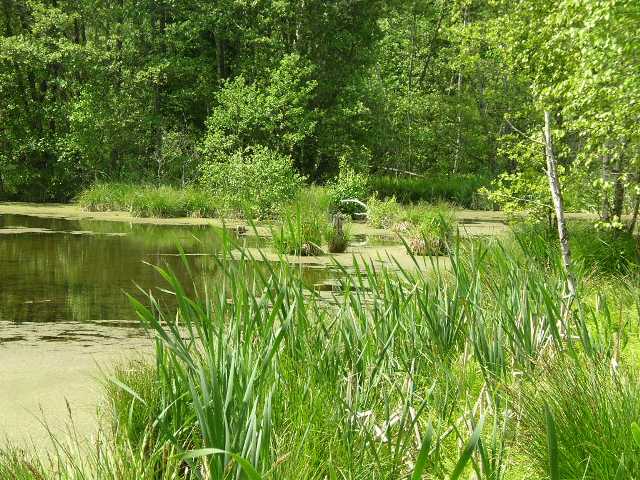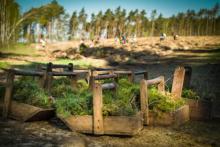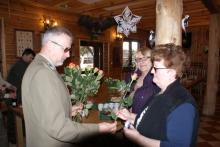 Asset Publisher
Asset Publisher
Polish forests
Poland is in the European lead, while concerning the area of all forests. They cover about 29,2 % of the country territory, and grow within the area of 9,1 million hectares. The overwhelming majority of the forests is state owned, of which almost 7,6 million hectares are managed by the State Forests National Forest Holding..
The number of Polish forest is still growing. The forestation rate of the country has increased from 21 % in 1945 to 29,2 % at the moment. Between 1995 and 2008, the forest area increased by 310 thousand ha. The basis for afforestation works is the "National Programme for Increasing the Forest Cover" (KPZL), assuming an increase of the forestation rate up to 30 % by 2020 and up to 33 % by 2050. Polish forests abound in flora, fauna and fungi. 65 % of the total number of animal species live there.
The forests grow in our country on poor soils, mainly because of the development of the agriculture in previous years. It influences the distribution of the types of the forest sites in Poland. Over 55 % of the forest areas is covered with coniferous forests. In other areas, there are forest sites, mainly the mixed ones. Their small part constitute alder and riparian forests – not more than 3 %.
In the years 1945 – 2011 the area of natural deciduous tree stands within the area of the State Forests National Forest Holding increased from 13 to 28,2 %.
Within the lowlands and uplands the most often occurring tee species is pine. It covers 64,3 % of the forest area of the State Forests National Forest Holding and 57,7 % of private and commune forests. In the mountains the predominant species is European spruce ( in the west) and European spruce with beech (in the east). Domination of pine is the result of carrying on sustainable forest management in the past. Once, the monocultures (crops or cultivations of one species) were the answer to the great demand of industry for wood. Such forests appeared to be quite fragile to climatic factors. They also were often the prey of pests' expansion.
In Polish forests, the share of other tree species, especially deciduous trees have been systematically increasing. The foresters have stepped aside from monocultures – that is why, they try to fit specific species of the forest stand to the natural stand, that would be proper for the given area. Thanks to that, in the years 1945 – 2011, the area of the deciduous tree stands within the lands of the State Forests National Forest Holding increased from 13 to 28,2 %. There occur more and more frequently the following tree species: oaks, ashes, maples, sycamore maples, elms, but also birches, beeches, alders, poplars, hornbeams, aspens, tilias and willows.
Our forests are the most often represented by the forest stands aged 40 to 80 years. The average age of the forest equals 60 years. More and more trees are of big size at the age over 80 years. Since the end of the Second World War, the forests' area has increased up to almost 1,85 million hectares.
Raport o stanie lasów w Polsce 2012
 Asset Publisher
Asset Publisher
100 rezerwatów na 100-lecie Lasów Państwowych
100 rezerwatów na 100-lecie Lasów Państwowych
Zgłaszając propozycję stu nowych rezerwatów przyrody, Lasy Państwowe chcą uczcić jubileusz 100-lecia powstania organizacji.
W 1924 r., wraz z odradzaniem się polskiej państwowości, powstała instytucja Lasów Państwowych. Od początku istnienia jej misją jest zrównoważone zarządzanie lasami i powiększanie zasobów leśnych. Mimo wojny światowej, zmiany granic państwa, gospodarki planowej w czasach PRL, ta misja jest realizowana. Miedzy Odrą a Bugiem rośnie lesistość i zasoby drzewne.
- Dziś, gdy nasz kraj jest niemal w 1/3 pokryty lasami, oczekiwania Polek i Polaków, którzy obserwują zmiany klimatu, koncentrują się na zwiększeniu ochrony lasów. W odpowiedzi na te oczekiwania leśnicy chcą zaproponować powołanie stu nowych rezerwatów przyrody – mówi Witold Koss, dyrektor generalny Lasów Państwowych.
Prace już się toczą. Do dzisiaj z nadleśnictw spłynęło ponad 200 propozycji nowych rezerwatów. Każda z nich jest teraz analizowana, tak by wybrać najcenniejsze i najbardziej różnorodne obszary. Oraz takie, w przypadku których istnieje najbardziej kompletne dane przyrodnicze. Po to, by zwiększyć szanse na szybkie utworzenie rezerwatów.
Leśnicy chcą działać transparentnie. Wybrane propozycje zostaną przedstawione Polkom i Polakom w Internecie. Tak by każdy po zapoznaniu się z opisem, zdjęciami i mapą mógł przedstawić swoje uwagi.
- Chcemy by nasza propozycja 100 rezerwatów odzwierciedlała różnorodność i bogactwo przyrodnicze lasów – deklaruje Jerzy Fijas, zastępca dyrektora generalnego Lasów Państwowych ds. zrównoważonej gospodarki leśnej, który jest koordynatorem przedsięwzięcia. I dodaje: - W tych przypadkach, gdy zaistnieje kilka propozycji nazwy, chcemy dać szansę zagłosowania on-line na jedną z nich.
Jak będzie wyglądał kalendarz akcji ogłoszonej w Międzynarodowym Dniu Lasów? W ciągu najbliższych dwóch miesięcy leśnicy dokonają wyboru setki propozycji nowych rezerwatów i ogłoszą je w Internecie. Kolejny etap to kompletowanie dokumentacji, również w oparciu o uwagi strony społecznej: samorządów, przyrodników i mieszkańców okolic nowych rezerwatów. W drugiej połowie roku gotowe wnioski zostaną skierowane do Regionalnych Dyrekcji Ochrony Środowiska, które są władne by ustanowić rezerwaty.
100 rezerwatów na 100-lecie Lasów Państwowych to nie tylko jednorazowa akcja jubileuszowa. Leśnicy zgłaszają i będą zgłaszać kolejne rezerwaty. Już dzisiaj 86% z ponad 1500 polskich rezerwatów znajduje się na gruntach Lasów Państwowych. Zajmują powierzchnię równą kilku parkom narodowym.
- Chcemy, by tych sto nowych rezerwatów przyrody było naszym urodzinowym prezentem dla Polek i Polaków. Liczę, że pierwsze rezerwaty z okazji 100-lecia powstaną jeszcze w tym roku. To będzie trwałe i najlepsze upamiętnienie naszego jubileuszu, jakie można sobie wyobrazić – podsumowuje dyrektor Koss.


 fot. Paweł Fabijański
fot. Paweł Fabijański
 fot. Paweł Fabijański
fot. Paweł Fabijański
 fot. Paweł Fabijański
fot. Paweł Fabijański





